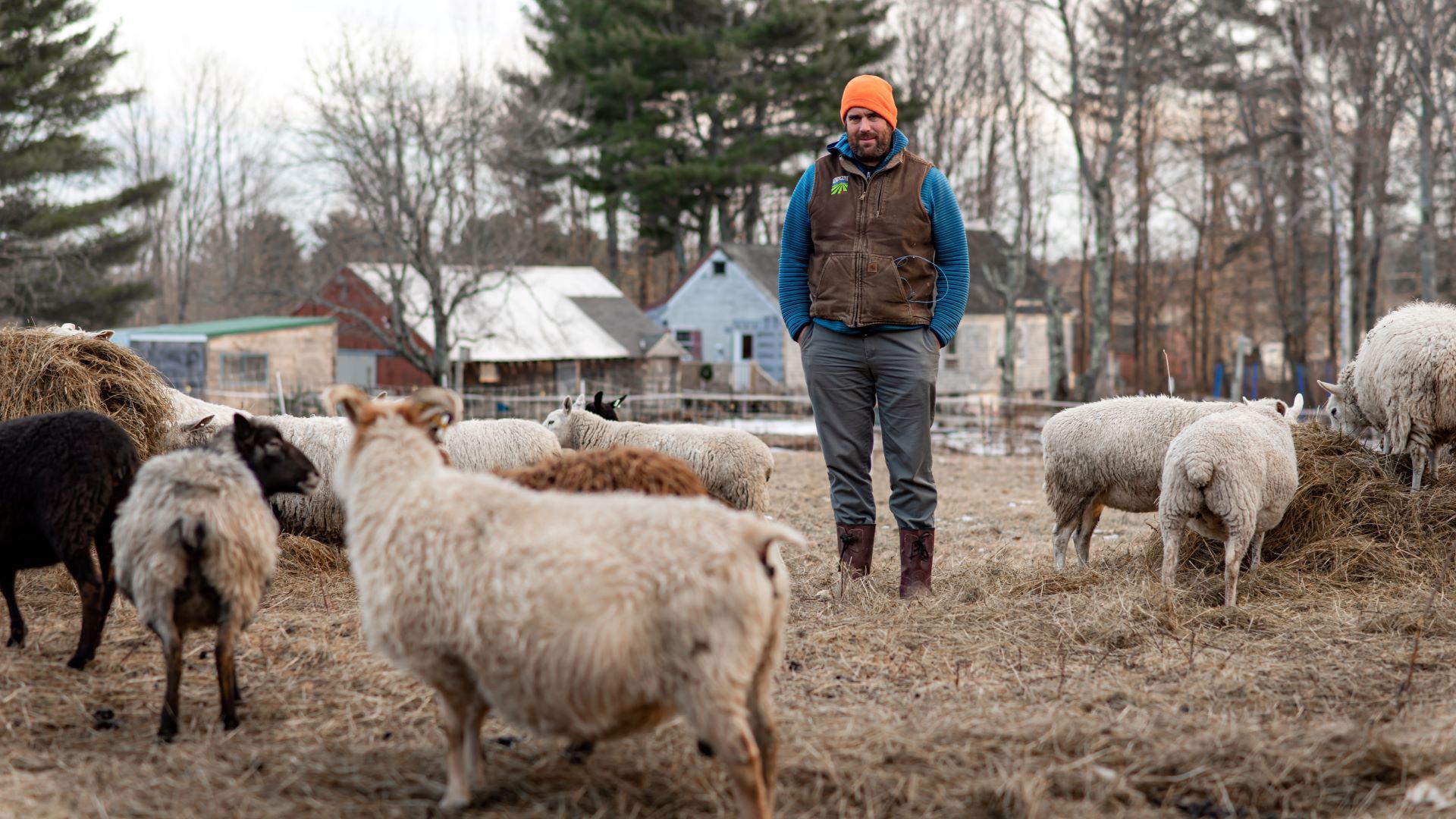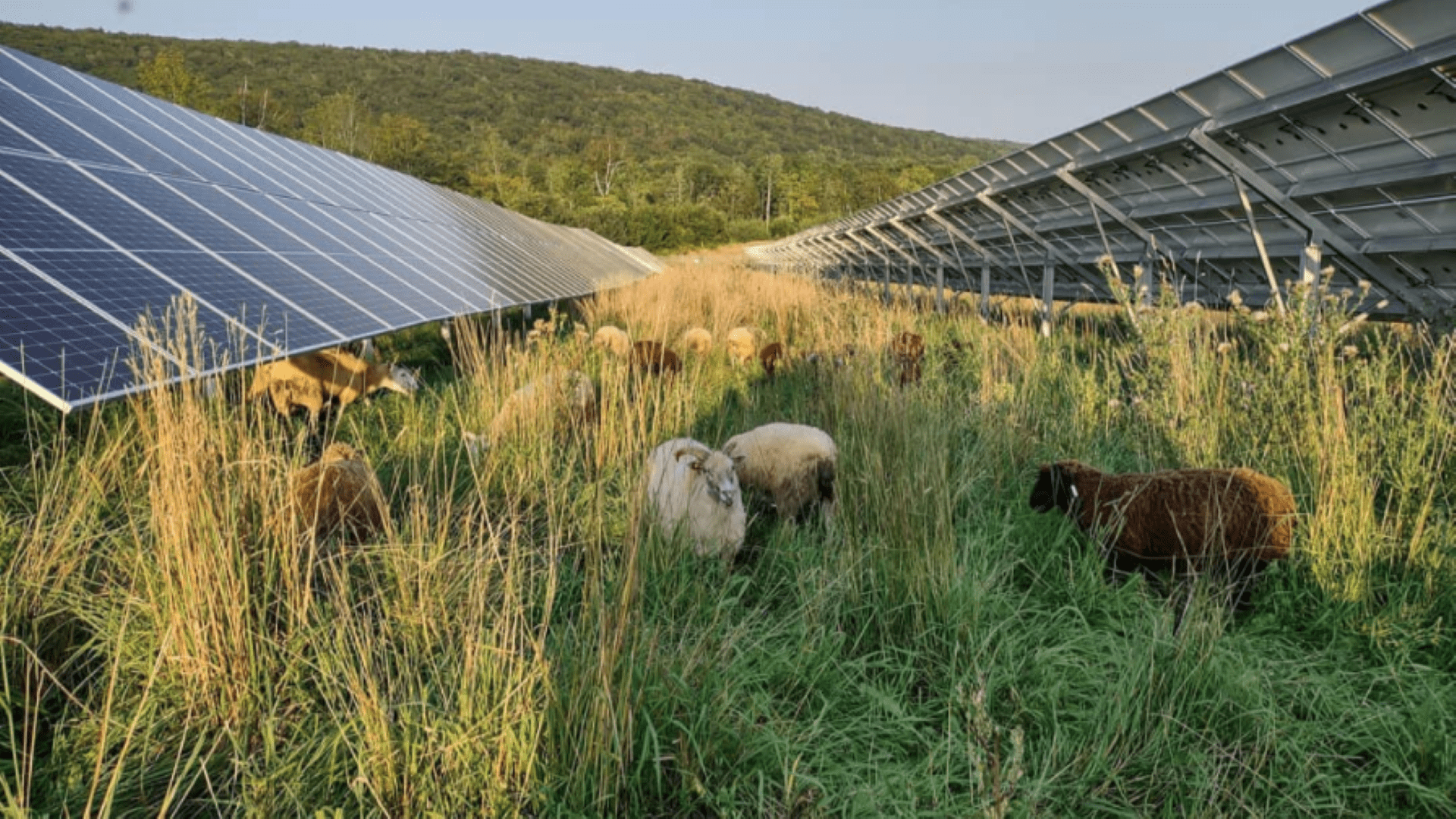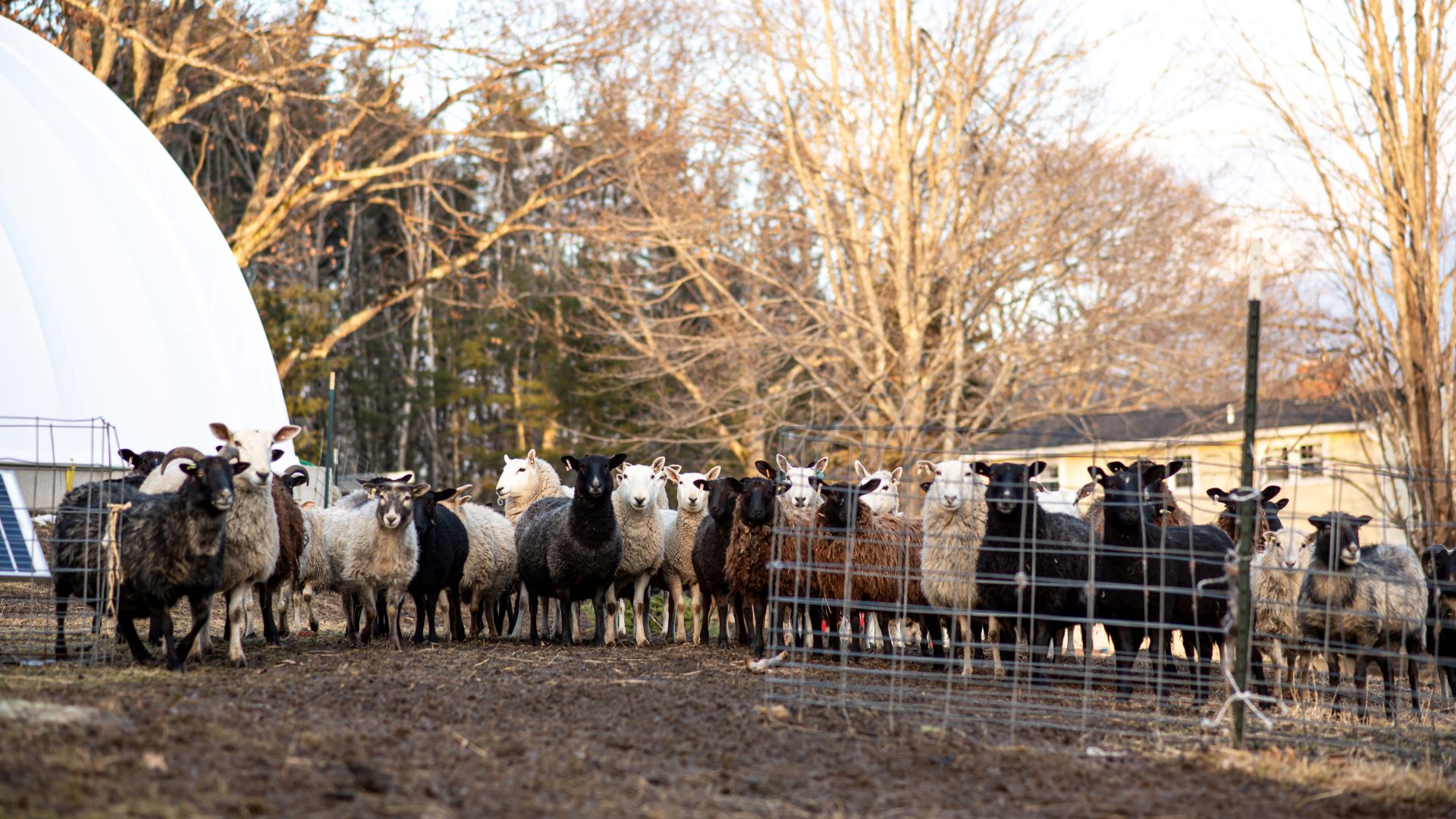
On an overcast afternoon in early July, Michael Dennett drove to a paddock near midcoast Maine to check on his sheep. They’d been there for a couple of days, and it was almost time to move them to another section of pasture.
Dennett, who owns Crescent Run Farm in Jefferson with his wife, Ryan, has been a sheep farmer for years. But this pasture was different from where he’d grazed sheep in the past: It was a commercial-scale solar project, and Dennett’s sheep were providing the mowing services.
“Ideally we get through a site within 30 days, particularly in the spring when grass is growing really fast,” said Dennett. Per his contract with ReVision Energy, Dennett does two grazes annually on several sites not far from the couple’s home.
Arrangements like Dennett’s — grazing sheep, or growing blueberries under solar panels — are known as “dual-use.” As Maine farmers lose prime land to solar developers who want it for panels, dual-use has emerged as a way to keep the land in production, yet also use it to generate energy from the sun.
Farmland, with its open fields, southern exposure and well-drained soils, is typically one of the easiest and cheapest places to put a solar project. But that type of land is also limited in Maine.
A lack of regulations around where solar can be sited has resulted in farms being converted to panels at a rapid clip, an analysis by The Maine Monitor found. Developers outcompete farmers for prime land, or offer working farmers attractive sums to take some land out of production.
In an effort to help stem the conversion, a report expected out this week from the Governor’s Energy office stakeholder group encourages farmers considering solar on actively farmed land to prioritize dual-use, to keep as much of that land in production as possible.
Except those systems, solar developers say, are so costly to construct that they aren’t viable in Maine on any grand scale.
“That’s the technology that we can’t afford in this state,” Matt Kearns, chief development officer of Longroad Energy and member of the Agriculture Solar Stakeholder Group, told members at a meeting in December.
Sheep are able to graze under traditional ground-mounted systems, and the shade the panels provide is great for the animals, said Dennett. But other kinds of dual-use projects, such as those that allow for vegetable farming or cattle grazing, require elevating panels and spacing them farther apart.

As Maine farmers lose prime land to solar development, dual-use farming has emerged as a way to keep the land in production, yet also use it to generate energy. Photo by Michael Dennett.
That means more materials, like steel and aluminum, and less energy (and thus less revenue) per acre compared to traditional ground-mounted systems, where panels can be placed close together.
“It’s very expensive, very hard to do,” said Kearns. “If we’re encouraging dual-use … that’s basically just saying the farmer can’t develop solar.”
Farmers can’t compete
Maine, the most heavily forested state in the U.S., has a finite amount of soil suitable for agriculture. About 10 percent of the state’s nearly 22 million acres are considered “soils of statewide importance.” Of those soils, 800,000 acres are considered “prime,” or land that is “of major importance in meeting the nation’s short- and long-range needs for food and fiber,” according to the U.S. Department of Agriculture.
Only half of the land suitable for farming in Maine is being farmed, and increasing local food production is one of the goals of Maine Won’t Wait, the state’s climate action plan. State officials have said they want to triple the amount of food consumed in Maine from state food producers to 30% by 2030.
But amid the state’s solar gold rush, much of that land has stopped growing food or fiber altogether. It now produces solar energy.
The state does not track how much farmland has been lost to solar projects, but a recent analysis by the Maine Audubon Society found that of 180 projects waiting to be reviewed by the Maine Department of Environmental Protection, 163 intersected with soils classified as prime or of statewide importance. That number is potentially much higher, since only projects on more than 20 acres go through full DEP review.
“The reality is we’re losing habitats. And the reality is we’re losing farmland,” said Sarah Haggerty, a conservation biologist with the Maine Audubon, in a presentation to the Agriculture Solar Stakeholder group.
The group, convened by the Department of Agriculture, Conservation and Forestry, and the Governor’s Energy Office, was tasked with seeking ways to protect important agricultural land while helping to reach solar generation goals.
While state and local officials have championed building those solar projects on capped landfills, brownfields and land that is otherwise unusable, that’s not where they’re ending up.
“We were pretty disappointed to find that 11 of the 180 projects intersect with gravel pits, and just six of them are uncapped landfills,” said Haggerty.

A healthy specimen at Michael Dennett’s Crescent Run Farm. Photo by Garrick Hoffman.
Solar is not the only threat to farmland, which is also being developed for housing and sold off as older farmers (the average age of a Maine farmer is 57) retire and there is no one to take their place. But what makes for good farmland — southern exposure, well-drained soils — also makes an excellent location for solar panels.
And once there are panels on that land, it’s highly unlikely it will ever be farmland again, at least not for many decades.
“I do not think we should expect large amounts of land to return to other uses from solar at the end of the first generation of life,” said Fortunat Mueller, a managing partner at ReVision Energy, during a recent stakeholder meeting.
Pressure from solar developers makes it more difficult for the roughly 25 percent of Maine farmers who lease their farmland to compete in the market. It also makes it harder for new farmers, many of whom lease land before they’re able to buy.
Younger farmers are “competing with developers who are offering $1,000 an acre on average, when we can maybe offer $200 an acre for row crop quality soil,” said Andy Smith, who participated in the committee and runs The Milkhouse, a dairy farm in Monmouth, with his partner, Caitlin Frame.
Farmers who lease hay fields, where they often pay $50 per acre or less for a lease, have been particularly hard hit by solar development, said Smith. “We’re at a massive disadvantage.”
The ‘wild east’ of solar
One reason Maine has seen such rampant solar development on farmland is that lawmakers have yet to enact rules around siting solar on those soils, or set regulations that would direct projects away from open space.
The state was flooded with proposals after the Legislature, in 2019, put in place incentives aimed at helping meet its renewable energy goals. With few regulations on where projects can be located, companies have typically looked to the cheapest, easiest options.
Other states and countries have grappled with the issue for years. Massachusetts, faced with rapid loss of farmland and open space to solar and housing development, set rules allowing solar development on agricultural land only if panels are raised at least 10 feet above ground and shading from the array covers no more than 50 percent of the field. It also pays companies with such projects more for the energy they produce.
Vermont, responding to a similar issue, enacted rules in 2017 that would pay companies more for putting panels on landfills, sandpits and brownfields, although many of those incentives are ending.
Building solar projects on landfills is 10% to 15% more expensive than siting them on undeveloped land. It requires altering construction practices to keep from compromising the landfill’s protective cap, which can increase labor costs. The presence of the cap also means that posts typically can’t be driven into the ground but must be stabilized with ballast or mounted on long concrete footings, an additional expense.
Landfills and brownfields, which often have remnants of industrial infrastructure and environmental hazards, may also require more in-depth review than putting posts and panels in an empty field. Landfill projects must be monitored to ensure they do not compromise the site’s integrity in the long term. Size is also an issue; many brownfields and landfills aren’t large enough for grid scale arrays.
Solar on commercial rooftops is possible, but companies often don’t want panels there because they take away from a building’s development possibility, Drew Pierson, head of sustainability at BlueWave Solar, told the stakeholder group.
That’s why developers say financial incentives are essential for companies to build on those kinds of sites or to put up dual-use projects on farmland.
“This all feels good. It sounds good. But it’s not going to get done without additional incentives,” said Jeremy Payne, executive director of the Maine Renewable Energy Association, in a December meeting.
Anything that increases costs to ratepayers will be a non-starter politically, the stakeholder group agreed.
“Massachusetts, sure. Big, big economy, a lot of ratepayers. Maine has a million and a half ratepayers,” said Kearns of Longroad Energy. “I don’t think we can afford that here.”
Solar can keep land in agricultural production
Solar can also provide an economic cushion for farmers, who often operate on thin and unpredictable margins. Many see it as a way to possibly return the land to farming in the future, even if it’s taken out of agricultural production in the short term, or as a way to use marginal areas that aren’t being actively farmed.
That’s the case for Rick Dyer and his family, who run Clemedow Farms in Monmouth. Dyer decided to allow a developer to install ground-mounted panels (Dyer wasn’t aware of dual-use at the time) on 45 of the 1,000 acres the family owns in order to help sustain the rest of the farm.
“It provides a buffer by which if all else were to end tomorrow,” said Dyer, “the economic value that comes in will pay the taxes on the entire property for the next 20 to 40 years and maybe beyond.”
The panels, he said, provide economic support that will help keep the rest of the land in open space and able to be farmed.
“Farming in Maine is difficult at best,” Dyer added. “For dairy farmers right now, it’s really trying. The same price of milk is getting paid to the dairy farmer today that was getting paid to my grandfather 60 years ago, and the cost of that tractor went from $15,000 to $150,000.”
Once the contract on the Clemedow Farms solar project is up, there are decommissioning plans that could allow the land to be put back into agricultural production.
Dyer hopes that will be the case. Had a housing development been built on that 45 acres, it would be nearly impossible to return that land to agricultural use, he pointed out. Putting up panels on one section will keep that hope alive.
Farmers want more evidence about dual-use
Economics aside, several farmers said they want to see more data that dual-use systems can work in Maine before agreeing to put panels on productive land.
“There’s a lot of talk about dual-use and working with farmers and all of this, but at the end of the day not much else is ever going to be able to happen under these arrays other than sheep grazing and bees foraging on clover or something,” said Smith, of The Milkhouse. Providing pollinator habitat is often counted as dual-use.

Sheep, such as these from Crescent Run Farm in Jefferson, are able to graze under solar panel systems. Photo by Garrick Hoffman.
“But that to me is kind of greenwashing to call that agriculture,” he said. “Not that it’s not important, but we’re not producing a lot of calories off that land.”
Smith and his partner, whose 250-acre farm has a substation in the center, were contacted by more than a dozen companies after the legislation passed in 2019. They have a rooftop array that offsets the farm’s energy use and were interested in putting up a dual-use system for their sheep and cattle to graze under. A developer told them it didn’t make “economic sense.”
While there are examples of crops successfully growing elsewhere under dual-use conditions, including a 24-acre vegetable farm with 3,200 panels in Colorado, it’s important to see examples of it working in Maine, said Smith.
Scientists are studying a dual-use array on a 10-acre patch of blueberry field in Rockport to see how many years it takes the berries to begin producing after the array is installed, and also to see how well they do in shade.
Pierson, of BlueWave Solar, told the stakeholder group that globally there are already many examples of this working.
But, he added: “It’s not all roses … (Farmers) are going to need to invest in new equipment, or even business models to figure out how this works.” That could mean learning new methods and departing from long-held philosophies on farming.
Certain pieces of equipment cannot fit between the poles, tractors may not be able to maneuver, and farmers have to be careful not to get chemicals on the panels themselves.
“There are low-impact methods that may not have been on farmers’ minds before that are now actually required because you don’t want to damage the solar project,” said Pierson.
Group recommends changes
The stakeholder group came up with several recommendations that it hopes will ease pressure on farmers while still allowing Maine to meet its renewable energy goals. A dual-use pilot program of at least 20 megawatts was suggested, along with the creation of a database with information on solar projects.
The report also suggests regulators consider streamlining the permitting process by making dual-use and/or co-location (in which panels are installed on a portion of farmland, as at Monmouth’s Clemedow Farms) eligible for permit-by-rule, which essentially allows companies to meet certain criteria and be exempt from full site law of development review.
“If we really are going to go big on clean energy, we want to be careful about, you know, just adding a ton of new restrictions,” said Kearns of Longroad Energy.
The report advocates for allowing farms to keep their agricultural use tax designation even if they put up solar panels, as long as farming remains on the land. Under current rules, farmers typically lose that designation on the portion of the land with panels, which can amount to many thousands of dollars each year.
In public comments, many urged for solar panels to be installed on farmland only as a last resort.
“I am an advocate for solar power, but I believe that panels should be on every rooftop and parking lot and brownfield before we cover farmland,” wrote David Asmussen, a commercial vegetable farmer.
Anything that slows solar implementation, argue developers and advocates, will hold Maine back from meeting its renewable energy goals. But farmers and others point out that a local food system and a biodiverse landscape are also some of the best ways to fight climate change, even if the benefit is harder to quantify financially.
“It’s really important that people understand that this is rapidly changing the landscape of Maine,” Smith added. “We’re talking about the development of tens of thousands of acres of land in the state, just to meet our initial (portion) of renewable energy goals.”
This article & photograph originally appeared in a The Maine Monitor post on January 16th, 2022.



